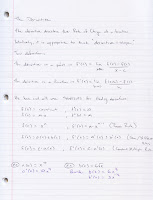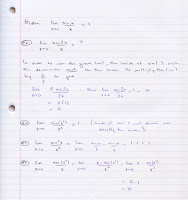The first concept is notational. Students know that if I'm referring to a function f(x), then its derivative is written f ' (x). New for today is the idea that if I'm referring to a function y, then its derivative is written dy/dx. I do not care for the notation y', though note that your book will use it on occasion. I think it's sloppy and doesn't impart as much information as is needed.
The second concept is the derivative of sin x. We worked out the derivative using the definition as well as a trig ID, some algebra and our known trig limits. Once sin x has been differentiated, the others follow quite nicely. For now, you only need to know:
f(x) = sin x, then f ' (x) = cos x
and
f(x) = cos x, then f ' (x) = –sin x
The proof of the derivative is shown in my notes below.






